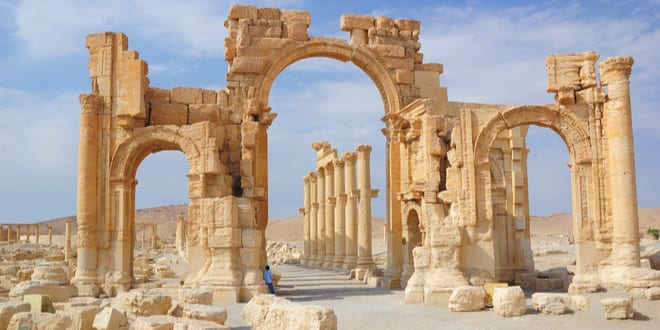After six years of laying in ruin, the Russians have begun reconstructing the Triumphal Arch of Palmyra in Syria that served as a gateway to a major pagan temple to Ba’al. Rebuilding the arch is predicted in the Talmud as preceding the Messiah.
The Arch of Palmyra; Temple to Ba’al
The ruins of the ancient city of Palmyra located about 135 miles north of Damascus were a huge tourist attraction, drawing 105,000 visitors a year until the devastating civil war broke out in Syria in 2011. The temple and much of the site were destroyed by the Islamic State (ISIS) in 2015. The Monumental Arch, a centerpiece of the site that was mostly destroyed, was built during the reign of Roman Emperor Septimius Severus in about 200 CE. It is estimated that only 30-40% of the stones in the arch remain.
Nazir Awad, director-general of the Syrian Antiquities and Museums Directorate, explained to Al-Ahed News that “meetings have taken place with Russian experts to discuss the work that will begin to restore and resurrect the Arch of Triumph. They are in the process of documenting and studying in order to outline the restoration work.”
“The necessary programs have been put in place to establish working groups concerned with documentation and preparation of documents as part of the restoration work and other teams to handle the rubble,” he added.
Awad points out that “the work did not actually start, but a working paper was drawn up from the Syrian side, with specific tasks prepared for teams, as this type of work follows global standards. The coronavirus is affecting the progress of the restoration work with the Association Stone Industry of Russia, and the Directorate is in contact with UNESCO and other institutions.”
The shortcode is missing a valid Donation Form ID attribute.
“The Syrian experts have put in place some plans, and there is no precise timetable for the completion of the work, but studies on restoration, rubble, and so on may be ready within six or eight months.”
The executive director of the Palmyra Restoration Fund, Sergei Tiglinov, said that specialists will make a 3D scan of all the elements, translate them into a virtual model, and then put them together in the restored monument.
Restoration work began this week after a memorandum of understanding was reached between the Syrian Ministry of Culture and the Association Stone Industry of Russia. In 2019, the State Hermitage Museum in Saint Petersburg announced plans to restore the site in conjunction with the Institute of the History of Material Culture of the Russian Academy of Sciences and Syria’s Directorate General of Antiquities and Museums (DGAM). The project will also be under the auspices of the United Nations Educational, Scientific and Cultural Organization (UNESCO).
Ba’al
The site, once a vital point on the Silk Road caravan route, has artifacts dating back to the Neolithic period. The Temple of Palmyra was dedicated in 32 CE to the worship of Ba’al. The earliest known inhabitants were the Amorites in the early second millennium BCE. As such, it hosted many monumental projects including the Temple of Bel (or Ba’al). The temple was built on the site of a prior pagan temple dating back to the third millennium BCE. The most recent of the temples were dedicated in 32 CE. Converted into a Christian church during the Byzantine Era, parts of the structure were modified into a mosque by Muslims in 1132. It remained in use as a mosque until the 1920s.
The arch stood at the entrance to the temple used to worship Bel, also known as Ba’al. Mentioned more than 90 times in the Bible, most notably when Elijah defeated the priests of Ba’al, also known as Moloch, in a contest to bring down fire from heaven to burn a sacrifice, Ba’al became the archetypical form of idol worship. Pantheistic, his adherents worshipped Mother Nature while denying the existence of a creator. Followers of Ba’al engaged in bisexual orgies and sacrificed human infants, burning them alive. Anthropologists conjecture that the child sacrifice was to cull the population after the inevitable outcome of wanton sexuality.
Gateway to Messiah
In Jewish tradition, the Arch of Palmyra may be alluded to as a harbinger of the Messianic era. An arch that is repeatedly built up and destroyed is described in the Talmud (Tractate Sanhedrin 78a).
The disciples of Rabbi Yossi the son of Kisma questioned him, asking when the son of David (the Messiah) will appear. And he answered: I am afraid you will request me a sign as well. And they assured him that they would not. He then said to them: When this gate will fall, be rebuilt and fall again, be rebuilt again and fall again. And before it will be rebuilt for the third time the Messiah will appear.
Rabbi Shlomo Yitzchaki, a preeminent medieval rabbi known by the acronym Rashi, explained this section of the Talmud, stating that the arch described by Rabbi Yossi was “a Roman arch in a Roman city.” The arch in Palmyra was indeed a Roman victory arch built when Palmyra was a Roman city.
The shortcode is missing a valid Donation Form ID attribute.




